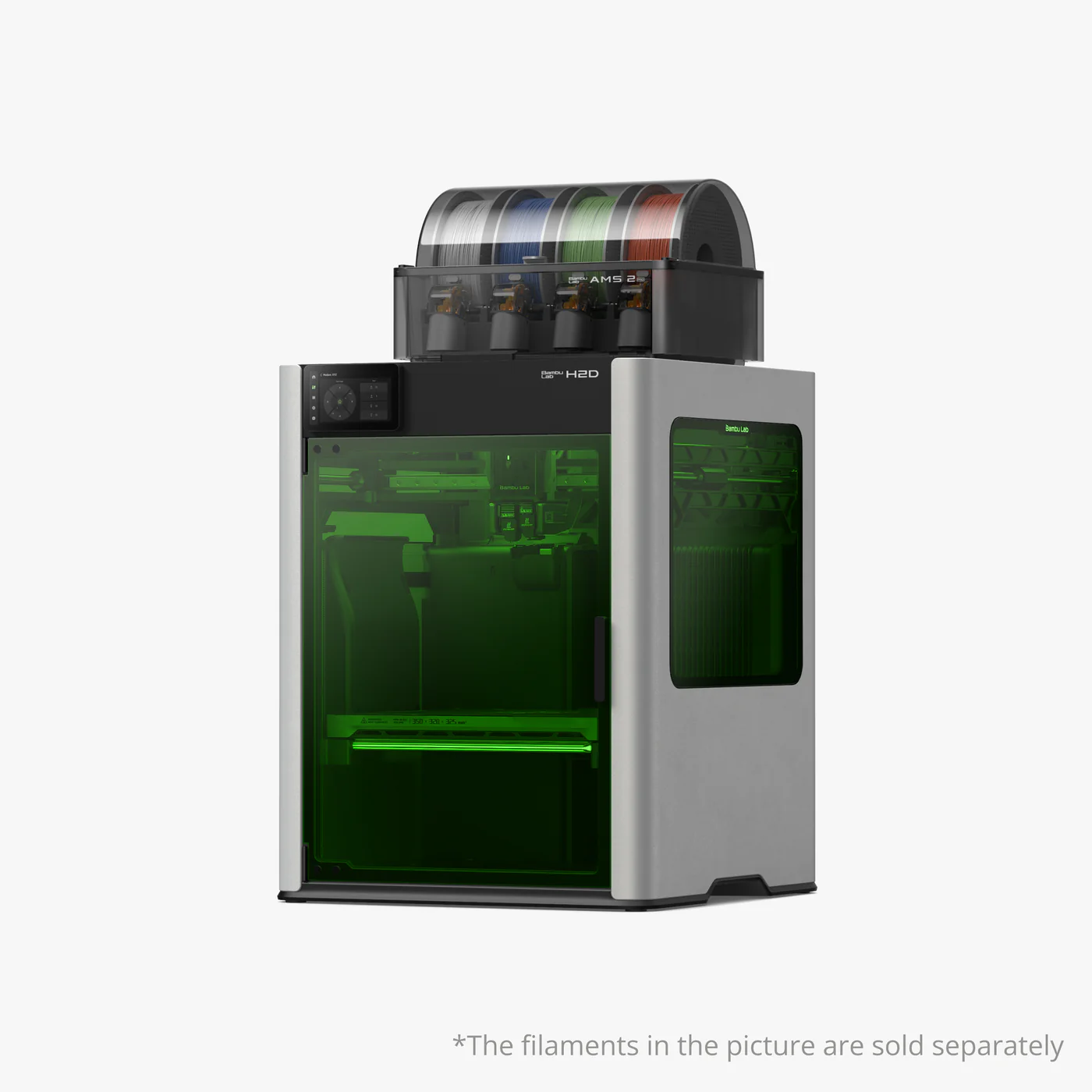Bambu Lab H2D 3D Printer – New Era of 3D printing?
Bambu Lab H2D 3D Printer: A Comprehensive Review of the Ultimate Maker Machine
After years of anticipation, Bambu Lab has unveiled the H2D, a groundbreaking Core XY 3D printer designed to redefine professional-grade fabrication. Combining industrial precision, multi-functional capabilities, and user-centric innovation, the H2D isn’t just a printer—it’s a hybrid workstation for creators. Here’s an in-depth look at what makes this machine a standout in the maker community.

Bambu Lab H2D Launch Details & Pricing
The Bambu Lab H2D is now available globally, with immediate shipping for the standard 3D printing model. The Laser Combo variants (10W and 40W) are slated to arrive in late July 2024, available for preorder. Pricing reflects its premium positioning:
- H2D Printer: Starts at $1,899 (standalone).
- H2D Combo: Includes AMS 2 Pro (4-material system) for $2,199.
- H2D Laser Combo: Bundles 10W laser, drag knife, and AMS 2 Pro at $2,799
The H2D undercuts competitors like Ultimaker and Prusa XL, offering advanced features at a fraction of industrial-grade pricing.
Design & Build Quality
The H2D’s robust construction reflects its professional focus:
- Frame: Die-cast aluminum and steel components ensure stability, contributing to its 30kg weight.
- Enclosure: Features tempered glass doors (standard model) and green-tinted panels (laser combo) for safety.
- Display: A tiltable 4.3-inch touchscreen with a revamped UI offers smoother navigation and offline functionality.
Though sleek, the laser combo’s plastic panels feel less premium and are prone to scratches.
Core 3D Printing Capabilities
1. Dual-Nozzle Innovation
The H2D’s standout feature is its dual-nozzle system, engineered for speed and precision:
- Adjustable Nozzle: The left nozzle retracts when inactive, eliminating collisions and oozing.
- Nozzle Cover: A motorized shield automatically seals inactive nozzles, preventing cross-contamination.
- Eddy Current Sensor: Measures nozzle alignment before each print, ensuring layer accuracy.
Multi-Material Mastery:
- Print incompatible materials (e.g., PLA + TPU) without clogs.
- Dual-nozzle mode cuts multi-color print times by 60% (e.g., a 5-hour Panda model drops to 2 hours).
2. Build Volume & Heated Chamber
- Dimensions: 350 x 320 x 325 mm (reduced to 300 mm for dual-nozzle prints).
- Active Heating: The chamber heats to 65°C, minimizing warping in ABS, ASA, and Nylon.
- PEI Build Plate: Ships with a textured sheet, though uneven bed heating caused minor adhesion issues during testing.
3. AMS 2 Pro & AMS HT

Bambu Lab’s new material systems elevate convenience:
- AMS 2 Pro: A 4-spool unit with auto-drying technology. Active vents expel moisture during drying cycles, then seal for airtight storage.
- AMS HT: Supports high-temp materials (up to 85°C) and flexible filaments via a bypass feed.
- Backward Compatibility: Both units work with older Bambu Lab printers post-firmware update.
Laser & Cutting Tools: Beyond 3D Printing
The Laser Combo transforms the H2D into a hybrid workstation:
10W/40W Laser Module
- Safety First: Flame sensors, emergency stop, and air filtration mitigate fire risks.
- Performance: Engraves metals, cuts wood (5mm with 10W; 15mm with 40W), and handles colored acrylic.
- Software: Bambu Suite offers intuitive design tools, though lacks third-party app integration.
Drag Knife & Plotter
- Precision Cutting: Tackles vinyl, cardstock, and stickers with ±0.3mm accuracy.
- Pen Plotter: Compatible with standard pens for detailed schematics or artwork.
Setup: Swapping tools takes minutes, but residue from laser cutting may affect long-term printer maintenance.
Performance & Real-World Testing
Print Quality
- Detail: 0.2mm layer Benchy showed flawless surfaces, though input shaping slightly softened edges.
- Speed: Default profiles prioritize reliability over speed (47 minutes for a standard Benchy).
- Material Range: Handles PLA, PETG, TPU, and high-temp polymers like CF-Nylon effortlessly.
Multi-Color Printing
- Filament Savings: Dual-nozzle + AMS setups reduce waste by 70% compared to traditional purging.
- Limitations: Still requires purge towers, and 5-color prints lag behind Prusa XL’s tool-changer speed.
Laser Engraving
- Results: Crisp engravings on wood and metal, though grayscale image support is basic.
- Air Filtration: Effective but requires manual activation—an odd oversight for a “smart” system.
Drawbacks & Considerations
- Complex Maintenance: Clearing jams on the advanced printhead is time-consuming.
- TPU Challenges: Flexible filaments require external routing, complicating workflows.
- Software Quirks: Nozzle cam feeds aren’t viewable remotely, and bed-leveling defaults caused early adhesion issues.
- Price: At $1,899+, it’s inaccessible for hobbyists but justified for professionals.
Why the H2D Stands Out
- All-in-One Versatility: Switch between 3D printing, laser cutting, and plotting effortlessly.
- Pro-Grade Reliability: Linear rails, servo motors, and HEPA filtration ensure consistent output.
- Smart Ecosystem: Bambu Studio’s “Filament Saving Mode” optimizes material use, while Makerworld integration fuels creativity.
Final Verdict: Who Should Buy It?
The Bambu Lab H2D is a triumph for professional makers and small workshops. While its price and complexity deter casual users, it excels as a hybrid fabrication hub. Competing with the Prusa XL in print quality and the Snapmaker in versatility, the H2D carves its niche with smarter workflows and Bambu Lab’s polished ecosystem.
For those needing industrial-grade multi-material printing or occasional laser work, the H2D is worth the investment. However, dedicated hobbyists may find its learning curve and cost prohibitive.
Keywords: Bambu Lab H2D, 3D printer, multi-material printing, laser engraving, AMS 2 Pro, Core XY printer.
